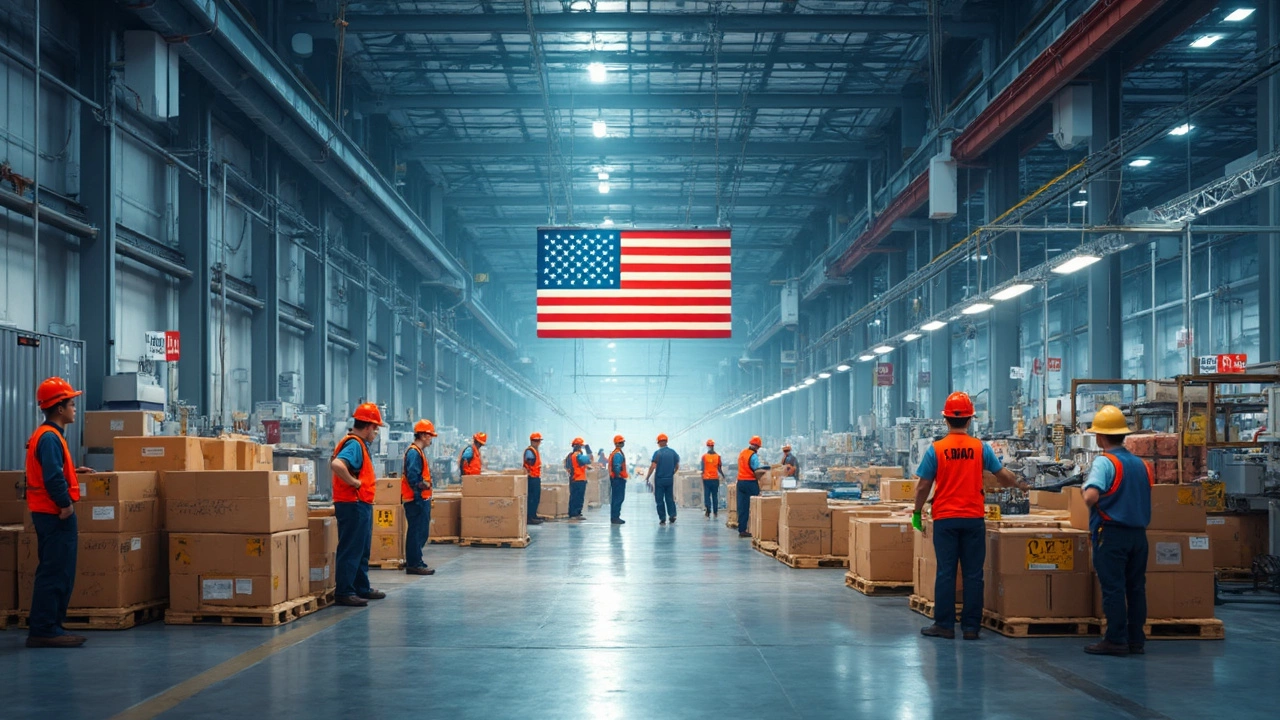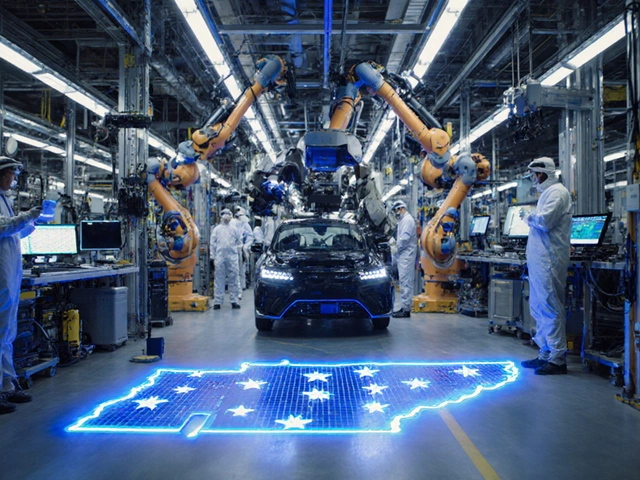If you start flipping over stuff you own—like kitchen gadgets, phones, game consoles—odds are, most don’t say “Made in USA.” American manufacturing isn’t totally gone, but a big chunk of it is now happening in other countries like China, Mexico, and Vietnam. This shift didn’t happen overnight. It slowly picked up steam, especially after the late 1990s when trade rules changed and companies wanted to cut costs big time.
Why does this even matter? It’s not just about bragging rights for local products. Outsourcing hits jobs, local towns, and the stuff we can get during a crisis—you’ve probably noticed how it affected things like masks and medicine when global supply chains got messy.
Before we start digging deeper, here’s one quick fact: According to the Bureau of Economic Analysis, about half of all stuff sold in the U.S. that’s labeled 'manufactured goods' is either made overseas or built here using imported parts and pieces. That should show you just how tangled and global the whole system is now.
- The Outsourcing Surge in American Manufacturing
- Why Companies Move Production Overseas
- How Much Is Actually Outsourced? Fresh Data
- The Impact on U.S. Jobs and the Economy
- Cracking the ‘Made in USA’ Label
- Government Moves: Can Manufacturing Come Home?
The Outsourcing Surge in American Manufacturing
The big wave of outsourcing in U.S. manufacturing took off in the late 1990s. Before that, factories were packed with local workers making everything from toys to electronics. Once companies spotted cheaper labor and fewer rules in places like China and Mexico, the shift gained speed. The North American Free Trade Agreement (NAFTA) kicked in around 1994 and made it even easier for U.S. brands to set up shop or buy parts abroad. Things ramped up even more after China joined the World Trade Organization in 2001. Suddenly, ‘Made in China’ stopped being rare and started becoming the norm in stores everywhere.
Between 2000 and 2010, the U.S. lost almost 6 million factory jobs. It wasn’t just robots—outsourcing was the biggest reason. This wasn’t always about shipping full products out; lots of American companies started sending only some steps of production, like making circuit boards or sewing clothes, to other countries and finishing the rest here. That’s why you might see labels like “assembled in USA with imported parts.”
Here’s the kicker: U.S. manufacturing output (the value of stuff made here) hasn’t dropped that much over time, but the number of people working those jobs sure has. Cheaper labor, fewer regulations, and easy shipping made outsourcing extra tempting for business leaders trying to compete on price. Whole industries, like clothing and electronics, saw most of their manufacturing move overseas virtually overnight. Just check your shirt tag or the bottom of your TV for proof.
Why Companies Move Production Overseas
It’s not a mystery why American companies started shifting work outside the country—money talks. The biggest reason is simple: labor costs are way lower in places like China, Mexico, and Southeast Asia. U.S. factory workers make about $25 an hour on average, while a factory worker in Vietnam might make less than $3 per hour. When you multiply those paychecks by hundreds or thousands of employees, the savings add up. That’s a clear reason big brands like Apple and Nike started making most of their stuff abroad.
It’s not just labor, either. Many countries offer tax breaks or even help pay for setting up a factory, all to attract foreign business. China, for example, poured billions into building industrial zones and offered deals on utilities to sweeten the pot for global manufacturers.
Raw materials are another factor. Some parts are just closer or cheaper to get in other countries. Think about electronics. Most of the small parts for smartphones, like microchips and batteries, come from Asia already. It makes sense for companies to stick their assembly lines nearby instead of shipping parts all over the world.
- U.S. manufacturing companies that want faster, cheaper ways to produce lots of stuff—like clothing, toys, or electronics—see outsourcing as a shortcut to get products to shelves sooner and at a lower price.
- Many big brands also like being close to fast-growing consumer markets overseas. If you build your product in Asia, it’s much easier to sell it to buyers there.
One last push is the pressure from big retailers and shareholders. Stores like Walmart want low prices to attract shoppers, so they demand suppliers cut costs wherever they can—usually by reducing production expenses overseas. Investors, meanwhile, want companies to boost profits and stock prices, which means trimming overhead wherever it makes sense.
Outsourcing isn’t always about greed. Sometimes, it’s about survival. If a rival slashes prices by outsourcing, it’s hard for a company paying higher wages in the U.S. to keep up without doing the same. That’s why this trend keeps rolling, even if lots of people wish things worked differently.
How Much Is Actually Outsourced? Fresh Data
The talk about U.S. manufacturing getting shipped overseas isn’t just hype—it’s backed by hard numbers. Let’s get straight to the facts. In 2024, about 35% of all manufacturing jobs that were in the United States during the late 1970s are now handled by workers in other countries. The U.S. Bureau of Labor Statistics points out the country lost around 7 million factory jobs since 1980. But it’s not just jobs—whole parts of things we buy are made elsewhere, even if the item gets assembled here.
Here’s a look at how much of the stuff we use every day is actually imported, along with the sources:
| Category | Percent of U.S. Sales Imported (2023) | Top Source Country |
|---|---|---|
| Electronics | 75% | China |
| Clothing & Footwear | 98% | Vietnam, China |
| Automotive Parts | 55% | Mexico, Canada, China |
| Pharmaceuticals | 68% | India, Europe |
| Home Appliances | 70% | China, Mexico |
So when you go out and buy a new phone, shirt, or microwave, there’s a strong chance it wasn’t made on U.S. soil. Even American cars—ones with big local brands—can have around half their value in imported components.
Curious about total outsourced value? In 2023, imports of manufactured goods hit around $2.5 trillion, according to the U.S. Census Bureau. That means about half of every dollar spent on manufactured goods went to something either made or finished somewhere else. It’s a different story than a few decades back, where most things on store shelves really were American-made.
Bottom line: outsourcing in American manufacturing isn’t just a trend—it’s the reality for everything from jeans to jet engines. These numbers don’t lie, and they show how global the supply chain for everyday goods really is.

The Impact on U.S. Jobs and the Economy
When people talk about U.S. manufacturing being outsourced, the biggest worry is almost always jobs. In the early 2000s, right after China joined the World Trade Organization, American factories shed over 3.5 million jobs in less than ten years. That’s not a typo. In some regions like the Midwest, entire towns built around one big factory just dried up.
A lot of people think these jobs were just low-skill work, but that’s not the case. Many were skilled positions—machine operators, mechanics, even engineers. The punch didn’t just hit workers: small businesses supplying parts, delivery drivers, and local restaurants felt it too.
But it isn’t just about lost work. American factories used to drive the whole economy. A long time ago, manufacturing made up about a quarter of all U.S. jobs. These days, it’s around 8%. For perspective, look at the table below:
| Year | Manufacturing Jobs (millions) | % of total U.S. jobs |
|---|---|---|
| 1979 | 19.4 | 22% |
| 2000 | 17.3 | 13% |
| 2024 | 12.9 | 8% |
The ripple effects cash-wise are massive. Factory jobs used to pay way above average. The Economic Policy Institute highlighted that, on average, folks in manufacturing made about $1.78 more per hour than those in other industries. Losing these roles means less spending in local stores, less money for schools, and sometimes, more demand for government aid.
Is there any upside? Outsourcing let businesses cut prices on stuff like clothes, electronics, and even cars. That meant families saved money at the checkout. But the downside is clear—good jobs and a huge chunk of economic stability just vanished from some communities. When you hear politicians talking about "bringing jobs back," they're talking about filling that hole left behind by U.S. manufacturing moving abroad. It’s not just nostalgia—it’s basic economics hitting home.
Cracking the ‘Made in USA’ Label
Ever spotted “Made in USA” stamped on a product and thought that means every single part and piece was built right here? It’s not that simple. The Federal Trade Commission (FTC) has strict rules: for something to be advertised as ‘Made in USA,’ all or nearly all of it must be made in the States. But “all or nearly all” still leaves plenty of gray areas, especially with how global supply chains work.
Here’s the thing—if a company puts a “Made in USA” label on something, that doesn’t always mean 100% of it was made here. Some screws, chips, or fabric might come from overseas. According to the FTC, the main parts and processing need to be American for a product to legally earn the label, but the final call depends on whether foreign parts are “negligible.” Try explaining that at a dinner party!
Some products use phrases like “Assembled in USA” or “Designed in USA.” These mean totally different things. ‘Assembled’ could mean most pieces arrived in a box from another country and were put together here. ‘Designed in USA’ is even looser—it just means the concept, not the actual making, happened stateside. If you care about real American manufacturing, these labels can trip you up.
- Want to be sure something’s truly American-made? Look for products with FTC-certified “Made in USA” tags, and dig into company websites—some are clearer than others about where parts and pieces come from.
- Don’t get fooled by flag graphics or “USA-owned” claims either. Being owned by an American business doesn’t always mean the product is made here.
- Electronics are especially tricky. A phone might be assembled in the U.S. but use parts from five different countries. The U.S. manufacturing landscape is global, even when the label sounds local.
If you want transparency, brands focusing on “reshoring” (bringing production back home) tend to shout about it in their ads and packaging. They know a lot of shoppers are looking for real American-made goods and not just clever wording.
Government Moves: Can Manufacturing Come Home?
The U.S. government isn’t just sitting on the sidelines watching jobs ship out. Over the last few years, they’ve rolled out a bunch of programs and policies actually meant to bring manufacturing back—what they call “reshoring.” Some people are skeptical, but real money is being thrown at this goal. For instance, the CHIPS Act, passed in 2022, set aside over $50 billion just for boosting computer chip production in the U.S. So, we’re talking major investment, not just talk.
In 2021, President Biden signed the Build Back Better Act, loaded with incentives for companies that make products in the U.S. or use American-made parts. There are also tax credits, special grants, and even government purchases focused exclusively on goods made at home. Want a government contract? Firms now get more points if they promise to use American factories and workers.
The goal with these moves is pretty clear—shorten America’s global supply chains, create new jobs, and finally make sure we’re not left hanging if trade wars or pandemics hit again. Let’s break down what’s actually happening:
- U.S. manufacturing is getting billions in federal funding, especially in tech stuff like semiconductors, electric car batteries, and solar panels.
- Companies investing in new U.S. factories can qualify for big tax breaks and grants. Ford, for example, got millions for new battery plants in Kentucky and Tennessee.
- New "Buy American" rules now require the federal government to buy more products made on U.S. soil—up from 55% to 60% content, with plans to go even higher soon.
- The SelectUSA program run by the Commerce Department is out there wooing global firms to set up new sites in the United States.
If you’re running a small shop or own a factory, it’s actually worth checking out the grants and local incentives your state might be handing out. States are in friendly wars to nab jobs—Texas, Arizona, and Ohio are just a few dropping huge incentives to lure companies with free land or infrastructure dollars.
All this said, shifting the big trends won’t happen instantly. Labor costs are still lower overseas, and it’s tough to rebuild lost know-how. But for the first time in decades, there’s clear evidence of factories opening up again. Even experts who doubted reshoring say the momentum is real this time. Will it bring everything back? Definitely not. But U.S. manufacturing looks a lot less like an empty shell than it did a few years ago.






